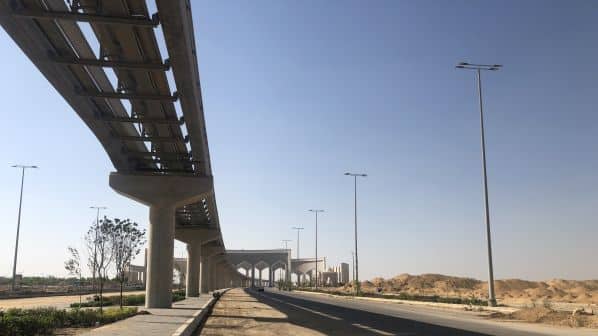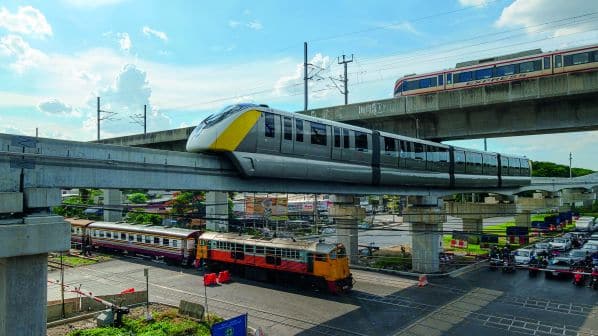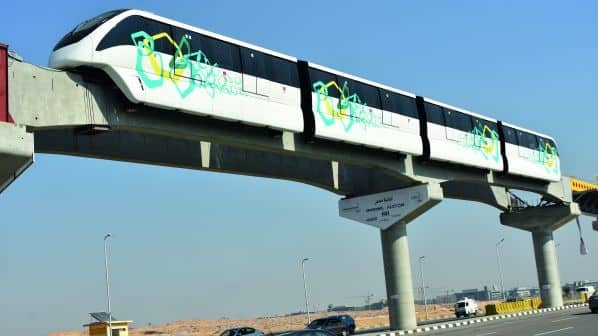RISING from the desert sands, Egypt’s New Administrative Capital (NAC) is progressively becoming a hub of modernity and government power. Plans for a new capital were announced in 2015 and many of the jobs that used to be based in the centre of car-choked Cairo are now located in the new city, which lies 45km to the southeast.
Architecturally impressive buildings line the relatively serene and landscaped streets of the new capital. Chief among them are the new Presidential Palace and the House of Representatives, and just outside of the NAC’s centre, the Islamic Cultural Centre, which houses the largest mosque in Africa with capacity for 130,000 worshippers.
The approach to the city is equally striking. Six vast and distinctive arched gateways mark the border of the NAC. Visible from miles around, anyone entering the city limits has to pass through one of these imposing structures. This includes future visitors by monorail through the West Gate. The elevated East of Nile Line connects the new capital with Nasr City and New Cairo and serves 22 stations, including an interchange with metro Line 3 at its terminus at Cairo stadium and the Capital Train subueban line at Almasa Hotel. Virtually all of the 56.5km infrastructure is now complete and the first unpaid passengers are expected to test the section from NAC to New Cairo by the end of this year.
The East of Nile Line is complemented by the 45km West of Nile Line, which runs from the Mohansheen district in Giza west to 6th of October City, interchanging with metro Line 3 at Wadi El Nile station as well as the recently-completed Bashteel main line station. Land acquisition problems in the early stages of this project mean that this work is running slightly behind the East of Nile Line. Together, both lines stretch 101.5km and will serve a total of 35 stations, carrying an anticipated 500,000 passengers per day. Egypt is immensely proud of the project’s status as the world’s longest monorail network, surpassing Chongqing’s 98.1km two-line system. Posters at some of the East of Nile station construction sites reinforce this message.

The $US 4.5bn project is partly financed through loans worth €2.5bn with a 14-year repayment period from commercial banks facilitated by JP Morgan to Egypt’s New Urban Communities Authority (Nuca). UK Export Finance (UEF) is guaranteeing 80% of this financing. Construction started in 2019 shortly after a consortium led by Bombardier (now Alstom), and also including Egyptian companies Orascom Construction and Arab Contractors, secured a contract to design, build, operate and maintain both lines for 30 years.
Under the deal, Orascom Construction is building the East of Nile Line, and Arab Contractors the West of Nile Line. Alstom’s share of the contract is worth $US 2.85bn. It is supplying systems, including Cityflo 650 CBTC, which enables driverless operation of 280 Innovia 300 monorail cars, which have been built at Alstom’s plant in Derby, Britain. These vehicles can be operated in eight or four-car formations. A 350V x 350V dc traction power supply system provides current through a third and fourth rail mounted either side of the running beam. An optical fibre telecommunications network supports a public address system and a CCTV network, while the automatic fare collection system, delivered by Indra, will be compatible with those installed across the region’s wider transport network.
Depot visit
Hill International is acting as the project management consultant and hosted IRJ at its project office, next to the line’s future NAC depot. The shell of the main depot building is now complete with fit-out underway. Inside the depot, there are five bays, each able to accommodate two four-car trains with a noticeable difference in the layout compared with a conventional metro or rail depot; the distance between the depot tracks is wider due to the need to access bogies from one side of the train. The monorail train bogies are equipped with eight rubber tyres, which have a lifespan of approximately 80,000km, avoiding the need for wheel lathes.
The two and five-tonne overhead cranes are employed for light and heavy maintenance. With traction equipment located underneath the trains, there is no overhead walkway.
Just outside, and visible from the roof of the control centre, the future East Line fleet is stabled, ready for further testing on the line, which heads off towards the NAC and Station 22, 3.5km down the track. Testing has taken place with the trains on this stretch and the hope was for further dynamic testing on additional stretches to begin as IRJ went to press.
The elevated monorail structure has a noticeably smaller footprint than the Capital Train suburban railway, dubbed LRT, which is already serving the NAC. The monorail line nestles seamlessly within the median of the busy roads that the alignment follows in New Cairo. The concrete structure is anchored by piles of 1.5-2.4 diameter piles up to a depth of 50m, supporting a single pier and two running beams. It is designed to be low maintenance, with an emergency and maintenance walkway suspended beneath the beams. There are also cable trays for power supply, signalling and telecommunications systems.
“It is a project with really big cost benefits but does require a team with experience to implement.”
Mr Matt Oakley, Hill’s project director for the monorail
A 30m section of double-track monorail infrastructure requires around 150 tonnes of concrete, which compares with 450 tonnes for a similar section of elevated metro. The speed of construction in Egypt has been extremely impressive. As Mr Matt Oakley, Hill’s project director for the monorail, reveals to IRJ, construction teams were delivering 1km of elevated structure per week at the peak of work, including 30-40 piers and 60-70 running beams. This is especially laudable when compared with the typical LRT structure, which can be delivered at a maximum rate of 100m a week, according to Oakley.
Oakley has experience of implementing the Kuala Lumpur monorail and light metro systems in the late 1990s, as well as the Palm Jumeirah monorail and light rail network in Dubai. He has witnessed a fast evolution in the capabilities of monorail technology over the past 30 years and is serious about it as a viable alternative to an elevated light metro.
“It is now up there on a par with other systems,” he says. “It is a project with really big cost benefits but does require a team with experience to implement.”
Indeed, Cairo has pushed the boundaries of what is possible with monorail construction, according to Mr Marko Kroenke, president of the International Monorail Association. He says the project has benefitted from its construction on a greenfield site and long straight sections between stations in some locations. This helped simplify the prefabrication of concrete structures at purpose-built precasting yards close to each of the lines, which are moved to the construction site at night as and when required.
With no secondary track with monorail, the precast beams form the final running surface for the rubber-tyred vehicles. This requires precise tolerances of +/-3mm to achieve the necessary vertical and horizontal geometry for all monorail applications, including curve radii as little as 60m on mainline and 45m in the depot, spiral transitions and superelevation of up to 10%, and gradients of up to 6%.
Among the comparable performance benefits is the capacity of the Egyptian lines to carry 45,000 passengers per hour in each direction at speeds of up to 80km/h. Cairo’s trains will run at 2min 30s intervals at peak times for the initial opening. However, the systems has been designed to operate at 90s intervals during peak periods and 3 min off-peak.
Monorail construction costs around half of a comparable elevated metro: approximately $US 50-60 million per km. In addition, while stations are relatively grand on the two Egyptian lines, it is possible to build more modest structures to reduce costs. “Interchange is what passengers are looking for,” Oakley says. “Monorails lend themselves to that due to their small footprint and the ability to minimise the connection distance due to their superior geometry criteria.” Rolling stock is also comparable in cost with metros, with larger orders affording the usual economies of scale.

The length and expected passenger traffic of the two new lines in Cairo means that arguably monorail is not the best solution here. Kroenke says that monorail’s “sweet spot” is a system with capacity for 25,000 passengers per hour, per direction. This is greater than a light rail system, which is suitable when there is enough space, but not the same capacity as an underground heavy metro, which is the least disruptive on the surface, but much more expensive and time-consuming to build.
When the choice is taken to build elevated infrastructure, Kroenke believes monorails warrant their place in the conversation due to offering similar capacity to a light metro but at a more favourable cost and with a faster rate of construction, one of the main reasons that persuaded NAT to pursue monorail in Egypt. Crucially, using a single straddle beam improves the journey experience for passengers as the view from the train is not obstructed by a safety wall. Monorails also benefit from relatively tight minimum curve radius of 45m compared with 100-120m for a heavy metro, enhancing viability in denser urban environments.
Turnouts
Limitations compared with steel rail systems include turnouts, where monorails typically require more space. There are two designs: a single straight section that can swing to the adjacent track; and a moveable S-shaped section connecting both beams, which replaces a straight section and was developed in Japan. There are 18 turnouts on each line in Cairo, including at depots.
“Like metros, we want to have as few switches as possible,” Kroenke says. “We want to reduce complexity in order to increase the overall availability of the system by having less failures.”
Kroenke adds that monorails are not really suited for colder climates where the accumulation of ice on the running beams could be problematic, as it is with any rubber tyre-based transport. However, he says tests have shown it is able to cope with snow, which is removed after a single vehicle pass.
Variations in monorail design reflect the different systems offered by the manufacturers working in the market. This includes the width of the beams, which vary from 690mm for Alstom’s and in some Chinese applications to 800mm on the Malaysia-developed system used in Kuala Lumpur and São Paulo, and 850mm on some Japanese lines. However, as Kroenke points out, these variations do not matter too much as interoperability is rare. Instead, a monorail is pitched as a turnkey system that is built as a sub-network within a larger public transport network, with the scale sufficient to warrant its own depot separate from existing sites.
Kroenke adds that significant work has taken place to improve ride quality. A bumpy sensation is noticeable in some earlier applications, which he says is the result of suboptimal concrete construction. He says improvements to the specifications for tolerances and in the manufacturing of the beams has helped to largely overcome these problems. There is also a growing understanding “between concrete guys who count in centimetres,” and the millimetre-based precision demanded by rail guidance systems.
The association is working to promote monorails in various markets and reports growing momentum; the 600km of monorail lines in operation around the world in 2022 is expected to double by 2026, according to a study by SCI Verkehr.
Major projects include Bangkok, where the Yellow and Pink lines totalling 64.9km opened in 2023. Alstom delivered the first monorail trains to the Dominican Republic for a new line in Santiago de los Caballeros in January while Panama is also building a monorail as the third metro line for its capital. Three lines are under construction in Monterrey, Mexico, and Line 17 is due to finally open in São Paulo later this year. China is also actively exploring implementation in several of its cities. And of course there’s Egypt.
Europe arguably remains the most difficult market for monorail proponents, where Kroenke says most mass transit projects have to be built on brownfield sites. “This is where it is difficult for monorail because it is a different mode,” Kroenke says. “A lot of cities are reluctant to implement something new.”
It is a different story in Asia and Latin America where most new projects are appearing. Monorail has traditionally been associated with theme parks, rather than mass transit networks. Yet with more than 80% of new applications providing mass public transport, it appears the technology is shedding this reputation. Egypt’s decision to adopt this transport mode for one of its key projects certainly offers food for thought.

